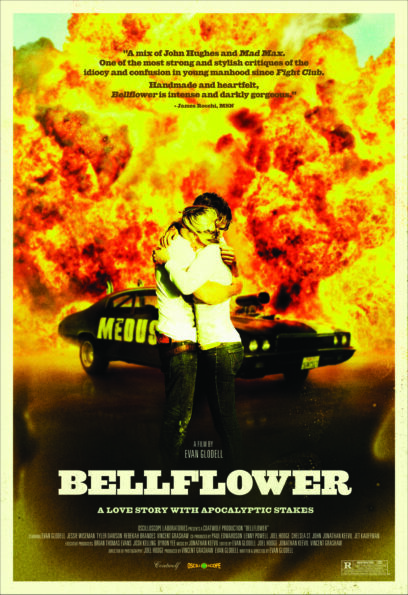 Although it, in the manner of many an indie film sensation, has been largely forgotten in the years since its debut, BELLFLOWER was easily one of the strongest “horror” movies of 2011. Yes, I said horror movie.
Although it, in the manner of many an indie film sensation, has been largely forgotten in the years since its debut, BELLFLOWER was easily one of the strongest “horror” movies of 2011. Yes, I said horror movie.
The film was sold as an actioner, but I doubt many Jason Statham fans will find its mix of visual experimentation and character-based psychological intensity very edifying (after the screening I attended an usher asked an elderly patron what he thought–“Yecch!” was the reply). The only real equivalent I can think of is the little-seen Australian gem METAL SKIN (1994), which like BELLFLOWER deals with car worship, romantic disillusionment and testosterone-fueled insanity.
BELLFLOWER was a $17,000 labor of love for writer-director-star Evan Glodell (whose long-awaited second feature, as of mid-2024, has yet to appear). It was shot on location (sans permits) in Ventura County, CA, amid sunbaked scenery that fits the proceedings perfectly. It’s here that the young Woodrow (Glodell) and his pal Aiden (Tyler Dawson) live out a MAD MAX inspired fantasy, spending their days aimlessly constructing bombs and flamethrowers. But then Woodrow meets the seductive Milly (Jessie Wiseman), for whom he falls hard.
The film’s early scenes, with Woodrow and Milly eking out a tentative romance during an impromptu road trip, suggest a Gen-X skewering indie from the nineties (the only thing missing is a cameo by Eric Stoltz). Yet there are what initially seem like show-offy and gratuitous elements that add a jarring note: distorted lenses that frequently blur out much of the frame, scattered flashbacks and forwards, etc. All comes clear around the film’s halfway point, when Woodrow catches Milly with another guy. In his ensuing befuddlement Woodrow is hit by a car, which damages his mind irreparably.
The entire film, in transpires, is a subjective product of Woodrow’s brain-addled consciousness. This explains the increasingly hallucinatory nature of the proceedings, and suggests that the ensuing events, which see Woodrow taking his MAD MAX-influenced fantasy persona a bit too literally, may be figments of his deteriorating mind.
The film has some flaws, most of them budget related. It seems downright inexplicable that with the innumerable references made to MAD MAX we never see a single clip from it; this was doubtless due to expensive rights issues, but the lack of any footage from the film just feels wrong. So too the fact that the protagonists spend a lot of time creating a fabulously souped-up, flame-belching automobile that’s never utilized in any meaningful way.
Yet BELLFLOWER satisfies. Its verve, confidence and sheer intensity testify that Evan Glodell is a mighty gifted filmmaker. Plus, in a development that’s extremely uncommon in no-budget cinema, the performances are all quite strong: Glodell evinces real acting chops in the lead, while MIDNIGHT MOVIE’S Rebekah Brandes makes a massive impression in a supporting role. The film, in short, is a triumph, and of definite interest to horror fans.
Vital Statistics
BELLFLOWER
Coatwolf Productions
Director/Screenplay: Evan Glodell
Producer: Evan Glodell, Vincent Grashaw
Cinematography: Joel Hodge
Editing: Evan Glodell, Vincent Grashaw, Joel Hodge
Cast: Evan Glodell, Jessie Wiseman, Tyler Dawson, Rebekah Brandes, Vincent Grashaw, Zack Kraus, Keghan Hurst, Alexandra Boylan, Bradshaw Pruitt, Brian Thomas Evans, Britta Jacobellis, Ceasar Flores, Chris Snyder, Dan Dulle, Jon Huck



